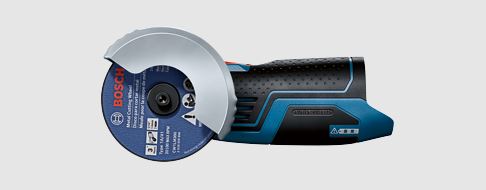BOSCH GWS12V-30 Max Brushless Grinder User Guide
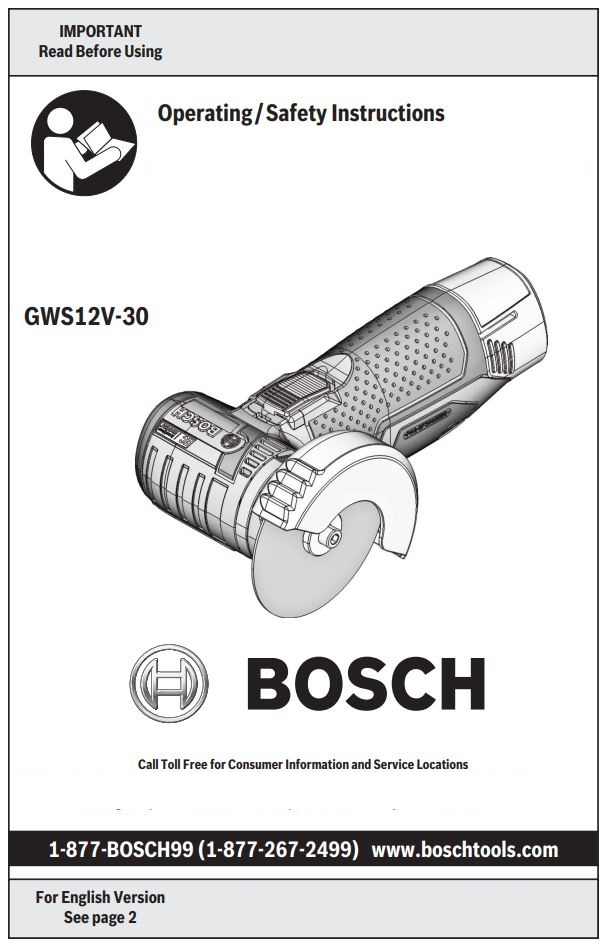
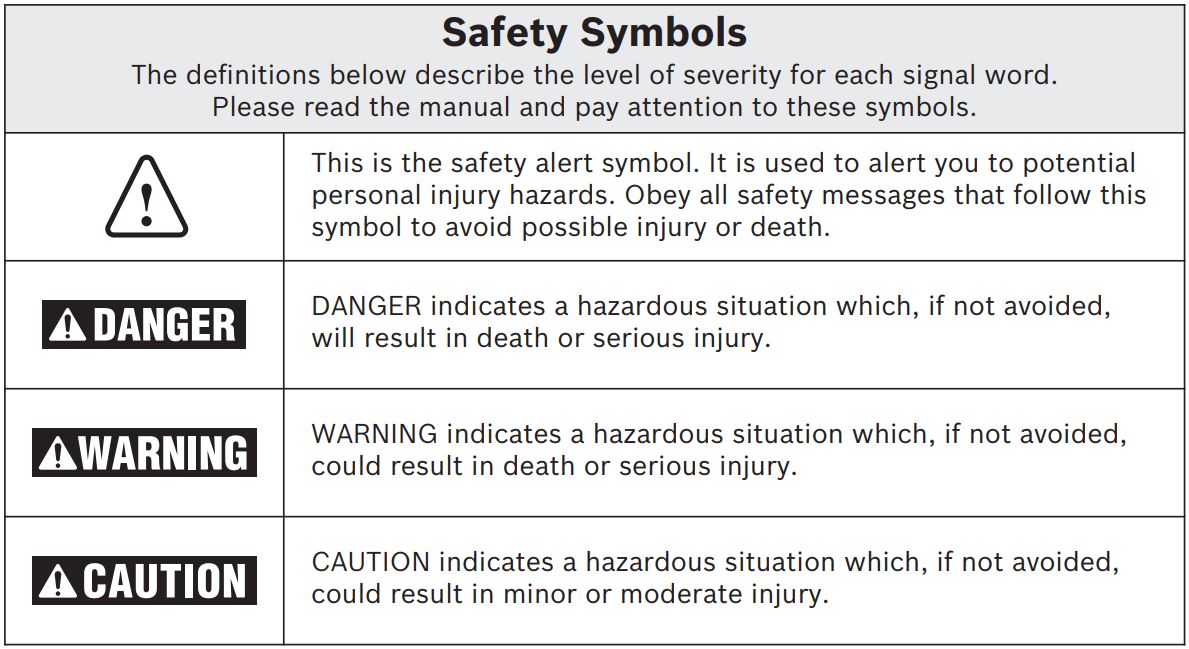
General Power Tool Safety Warnings
⚠ Read all safety warnings and all instructions. Failure to follow the warnings and instructions may result in electric shock, fire and/or serious injury.
SAVE ALL WARNINGS AND INSTRUCTIONS FOR FUTURE REFERENCE
The term “power tool” in the warnings refers to your mains-operated (corded) power tool or battery-operated (cordless) power tool.
Work area safety
Keep work area clean and well lit. Cluttered or dark areas invite accidents.
Do not operate power tools in explosive atmospheres, such as in the presence of flammable liquids, gases or dust. Power tools create sparks which may ignite the dust or fumes.
Keep children and bystanders away while operating a power tool. Distractions can cause you to lose control.
Electrical safety
Power tool plugs must match the outlet. Never modify the plug in any way. Do not use any adapter plugs with earthed (grounded) power tools. Unmodified plugs and matching outlets will reduce risk of electric shock.
Avoid body contact with earthed or grounded surfaces such as pipes, radiators, ranges and refrigerators. There is an increased risk of electric shock if your body is earthed or grounded.
Do not expose power tools to rain or wet conditions. Water entering a power tool will increase the risk of electric shock.
Do not abuse the cord. Never use the cord for carrying, pulling or unplugging the power tool. Keep cord away from heat, oil, sharp edges or moving parts. Damaged or entangled cords increase the risk of electric shock.
When operating a power tool outdoors, use an extension cord suitable for outdoor use. Use of a cord suitable for outdoor use reduces the risk of electric shock.
If operating a power tool in a damp location is unavoidable, use a Ground Fault Circuit Interrupter (GFCI) protected supply. Use of an GFCI reduces the risk of electric shock.
Personal safety
Stay alert, watch what you are doing and use common sense when operating a power tool. Do not use a power tool while you are tired or under the influence of drugs, alcohol or medication. A moment of inattention while operating power tools may result in serious personal injury.
Use personal protective equipment. Always wear eye protection. Protective equipment such as dust mask, non-skid safety shoes, hard hat, or hearing protection used for appropriate conditions will reduce personal injuries.
Prevent unintentional starting. Ensure the switch is in the off-position before connecting to power source and / or battery pack, picking up or carrying the tool. Carrying power tools with your finger on the switch or energizing power tools that have the switch on invites accidents.
Remove any adjusting key or wrench before turning the power tool on. A wrench or a key left attached to a rotating part of the power tool may result in personal injury.
Do not overreach. Keep proper footing and balance at all times. This enables better control of the power tool in unexpected situations.
Dress properly. Do not wear loose clothing or jewelry. Keep your hair, clothing and gloves away from moving parts. Loose clothes, jewelry or long hair can be caught in moving parts.
If devices are provided for the connection of dust extraction and collection facilities, ensure these are connected and properly used. Use of dust collection can reduce dust related hazards.
Power tool use and care
Do not force the power tool. Use the correct power tool for your application. The correct power tool will do the job better and safer at the rate for which it was designed.
Do not use the power tool if the switch does not turn it on and off. Any power tool that cannot be controlled with the switch is dangerous and must be repaired.
Disconnect the plug from the power source and/or the battery pack from the power tool before making any adjustments, changing accessories, or storing power tools. Such preventive safety measures reduce the risk of starting the power tool accidentally.
Store idle power tools out of the reach of children and do not allow persons unfamiliar with the power tool or these instructions to operate the power tool. Power tools are dangerous in the hands of untrained users.
Maintain power tools. Check for misalignment or binding of moving parts, breakage of parts and any other condition that may affect the power tool’s operation. If damaged, have the power tool repaired before use. Many accidents are caused by poorly maintained power tools.
Keep cutting tools sharp and clean. Properly maintained cutting tools with sharp cutting edges are less likely to bind and are easier to control.
Use the power tool, accessories and tool bits etc. in accordance with these instructions, taking into account the working conditions and the work to be performed. Use of the power tool for operations different from those intended could result in a hazardous situation.
Battery tool use and care
Recharge only with the charger specified by the manufacturer. A charger that is suitable for one type of battery pack may create a risk of fire when used with another battery pack.
Use power tools only with specifically designated battery packs. Use of any other battery packs may create a risk of injury and fire.
When battery pack is not in use, keep it away from other metal objects like paper clips, coins, keys, nails, screws, or other small metal objects that can make a connection from one terminal to another. Shorting the battery terminals together may cause burns or a fire.
Under abusive conditions, liquid may be ejected from the battery, avoid contact. If contact accidentally occurs, flush with water. If liquid contacts eyes, additionally seek medical help. Liquid ejected from the battery may cause irritation or burns.
Service
Have your power tool serviced by a qualified repair person using only identical replacement parts. This will ensure that the safety of the power tool is maintained.
Never service damaged battery packs. Service of battery packs should only be performed by the manufacturer or authorized service providers.
Power Tool-Specific Safety Warnings
Safety Warnings Common for Grinding, Sanding, Wire Brushing,
and Abrasive Cutting-Off Operations:
This power tool is intended to function as a grinder or cut-off tool. Read all safety warnings, instructions, illustrations and specifications provided with this power tool. Failure to follow all instructions listed below may result in electric shock, fire and/or serious injury.
Operations such as sanding, wire brushing, and polishing are not recommended to be performed with this power tool. Operations for which the power tool was not designed may create a hazard and cause personal injury.
Do not use accessories which are not specifically designed and recommended by the tool manufacturer. Just because the accessory can be attached to your power tool, it does not assure safe operation.
The rated speed of the accessory must be at least equal to the maximum speed marked on the power tool. Accessories running faster than their rated speed can break and fly apart.
The outside diameter and the thickness of your accessory must be within the capacity rating of your power tool. Incorrectly sized accessories cannot be adequately guarded or controlled.
Threaded mounting of accessories must match the grinder spindle thread. for accessories mounted by flanges, the arbour hole of the accessory must fit the locating diameter of the flange. Accessories that do not match the mounting hardware of the power tool will run out of balance, vibrate excessively and may cause loss of control.
Do not use a damaged accessory. Before each use inspect the accessory such as abrasive wheels for chips and cracks, backing pad for cracks, tear or excess wear, wire brush for loose or cracked wires. If power tool or accessory is dropped, inspect for damage or install an undamaged accessory. After inspecting and installing an accessory, position yourself and bystanders away from the plane of the rotating accessory and run the power tool at maximum no-load speed for one minute.
Damaged accessories will normally break apart during this test time.
Wear personal protective equipment. Depending on application, use face shield, safety goggles or safety glasses. As appropriate, wear dust mask, hearing protectors, gloves and workshop apron capable of stopping small abrasive or workpiece fragments. The eye protection must be capable of stopping flying debris generated by various operations. The dust mask or respirator must be capable of filtrating particles generated by your operation. Prolonged exposure to high intensity noise may cause hearing loss.
Keep bystanders a safe distance away from work area. Anyone entering the work area must wear personal protective equipment. Fragments of workpiece or of a broken accessory may fly away and cause injury beyond immediate area of operation.
Hold the power tool by insulated gripping surfaces only, when performing an operation where the cutting accessory may contact hidden wiring. Cutting accessory contacting a “live” wire may make exposed metal parts of the power tool “live” and could give the operator an electric shock.
Never lay the power tool down until the accessory has come to a complete stop. The spinning accessory may grab the surface and pull the power tool out of your control.
Do not run the power tool while carrying it at your side. Accidental contact with the spinning accessory could snag your clothing, pulling the accessory into your body.
Regularly clean the power tool’s air vents. The motor’s fan will draw the dust inside the housing and excessive accumulation of powdered metal may cause electrical hazards.
Do not operate the power tool near flammable materials. Sparks could ignite these materials.
Do not use accessories that require liquid coolants. Using water or other liquid coolants may result in electrocution or shock.
Kickback and Related Warnings
Kickback is a sudden reaction to a pinched or snagged rotating wheel, backing pad, brush or any other accessory. Pinching or snagging causes rapid stalling of the rotating accessory which in turn causes the uncontrolled power tool to be forced in the direction opposite of the accessory’s rotation at the point of the binding.
For example, if an abrasive wheel is snagged or pinched by the workpiece, the edge of the wheel that is entering into the pinch point can dig into the surface of the material causing the wheel to climb out or kick out. The wheel may either jump toward or away from the operator, depending on direction of the wheel’s movement at the point of pinching. Abrasive wheels may also break under these conditions.
Kickback is the result of power tool misuse and/or incorrect operating procedures or conditions and can be avoided by taking proper precautions as given below.
Maintain a firm grip on the power tool and position your body and arm to allow you to resist kickback forces. Always use auxiliary handle, if provided, for maximum control over kickback or torque reaction during start-up. The operator can control torque reactions or kickback forces, if proper precautions are taken.
Never place your hand near the rotating accessory. Accessory may kickback over your hand.
Do not position your body in the area where power tool will move if kickback occurs. Kickback will propel the tool in direction opposite to the wheel’s movement at the point of snagging.
Use special care when working corners, sharp edges etc. Avoid bouncing and snagging the accessory. Corners, sharp edges or bouncing have a tendency to snag the rotating accessory and cause loss of control or kickback.
Do not attach a saw chain woodcarving blade or toothed saw blade. Such blades create frequent kickback and loss of control.
Safety Warnings Specific for Grinding and Abrasive Cutting-Off Operations:
Use only wheel types that are recommended for your power tool and the specific guard designed for the selected wheel. Wheels for which the power tool was not designed cannot be adequately guarded and are unsafe.
The grinding surface of centre depressed wheels must be mounted below the plane of the guard lip. An improperly mounted wheel that projects through the plane of the guard lip cannot be adequately protected.
The guard must be securely attached to the power tool and positioned for maximum safety, so the least amount of wheel is exposed towards the operator. The guard helps to protect operator from broken wheel fragments, accidental contact with wheel and sparks that could ignite clothing.
Wheels must be used only for recommended applications. For example: do not grind with the side of cut-off wheel. Abrasive cut-off wheels are intended for peripheral grinding, side forces applied to these wheels may cause them to shatter.
Always use undamaged wheel flanges that are of correct size and shape for your selected wheel. Proper wheel flanges support the wheel thus reducing the possibility of wheel breakage. Flanges for cut-off wheels may be different from grinding wheel flanges.
Do not use worn down wheels from larger power tools. Wheel intended for larger power tool is not suitable for the higher speed of a smaller tool and may burst.
Additional Safety Warnings Specific for Abrasive Cutting-Off Operations:
Do not “jam” the cut-off wheel or apply excessive pressure. Do not attempt to make an excessive depth of cut. Overstressing the wheel increases the loading and susceptibility to twisting or binding of the wheel in the cut and the possibility of kickback or wheel breakage.
Do not position your body in line with and behind the rotating wheel. When the wheel, at the point of operation, is moving away from your body, the possible kickback may propel the spinning wheel and the power tool directly at you.
When wheel is binding or when interrupting a cut for any reason, switch off the power tool and hold the power tool motionless until the wheel comes to a complete stop. Never attempt to remove the cut-off wheel from the cut while the wheel is in motion otherwise kickback may occur. Investigate and take corrective action to eliminate the cause of wheel binding.
Do not restart the cutting operation in the workpiece. Let the wheel reach full speed and carefully reenter the cut. The wheel may bind, walk up or kickback if the power tool is restarted in the workpiece.
Support panels or any oversized workpiece to minimize the risk of wheel pinching and kickback. Large workpieces tend to sag under their own weight. Supports must be placed under the workpiece near the line of cut and near the edge of the workpiece on both sides of the wheel.
Use extra caution when making a “pocket cut” into existing walls or other blind areas. The protruding wheel may cut gas or water pipes, electrical wiring or objects that can cause kickback.
Do not use type 1 abrasive wheels designed for straight grinding.
Do not attempt to cut large stock or sheets of metal as this machine is not designed to be a dedicated cut-off machine.
Additional Safety Warnings
Do not use AC only rated tools with a DC power supply. While the tool may appear to work, the electrical components of the AC rated tool are likely to fail and create a hazard to the operator.
Keep handles dry, clean and free from oil and grease. Slippery hands cannot safely control the power tool.
Use clamps or other practical way to secure and support the workpiece to a stable platform. Holding the work by hand or against your body is unstable and may lead to loss of control.
Develop a periodic maintenance schedule for your tool. When cleaning a tool be careful not to disassemble any portion of the tool since internal wires may be misplaced or pinched or safety guard return springs may be improperly mounted. Certain cleaning agents such as gasoline, carbon tetrachloride, ammonia, etc. may damage plastic parts.
Use only Bosch BAT414 or the batteries listed in the battery /charger list. Using other types of batteries may result in personal injury or property damage.
Ensure the switch is in the off position before inserting battery pack. Inserting the battery pack into power tools that have the switch on invites accidents.
Always inspect accessories for damage (breakage, cracks) before each use. Never use if damage is suspected.
Do not use vacuum or other dust collection system when cutting metal. Sparks from metal cutting can cause fire in the collector.
⚠ Some dust created by power sanding, sawing, grinding, drilling, and other construction activities contains chemicals known to cause cancer, birth defects or other reproductive harm. Some examples of these chemicals are:
- Lead from lead-based paints,
- Crystalline silica from bricks and cement and other masonry products, and
- Arsenic and chromium from chemically treated lumber.
Your risk from these exposures varies, depending on how often you do this type of work. To reduce your exposure to these chemicals: work in a well ventilated area, and work with approved safety equipment, such as those dust masks that are specially designed to filter out microscopic particles.
Symbols
IMPORTANT: Some of the following symbols may be used on your tool. Please study them and learn their meaning. Proper interpretation of these symbols will allow you to operate the tool better and safer.
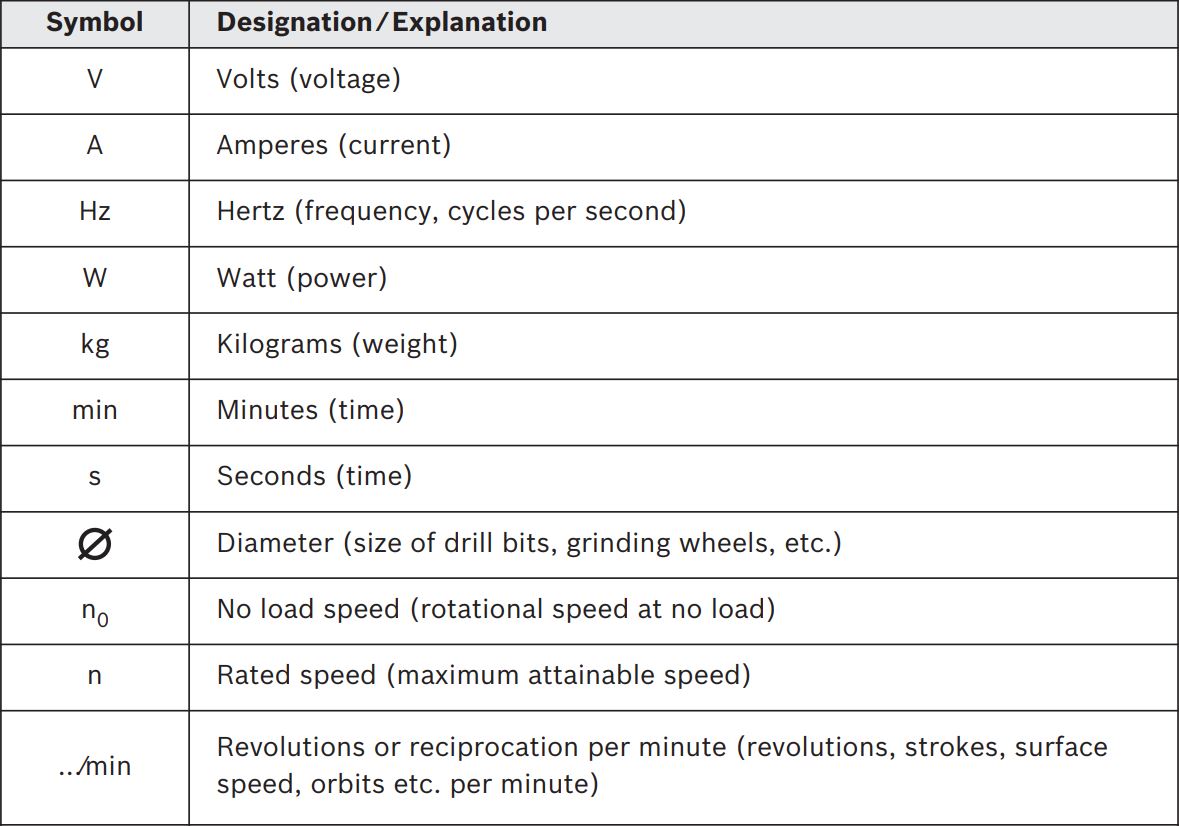

Important: Some of the following symbols may be used on your tool. Please study them and learn their meaning. Proper interpretation of these symbols will allow you to operate the tool better and safer.
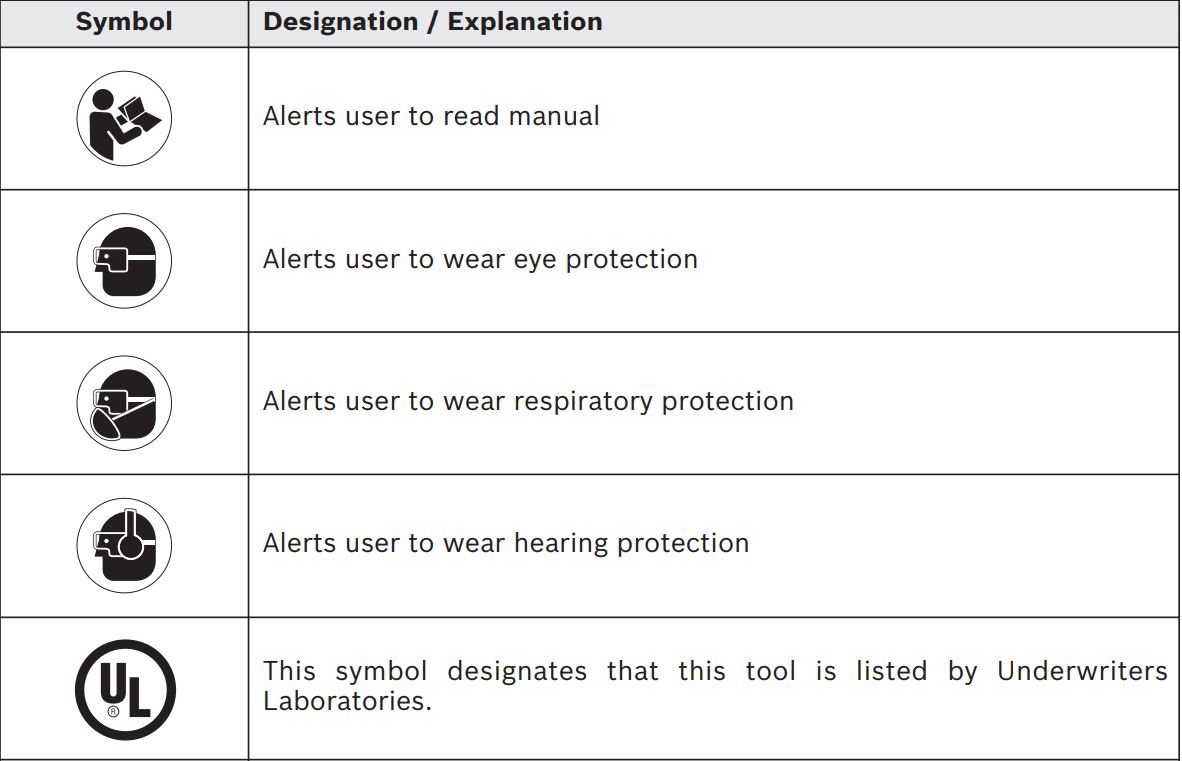
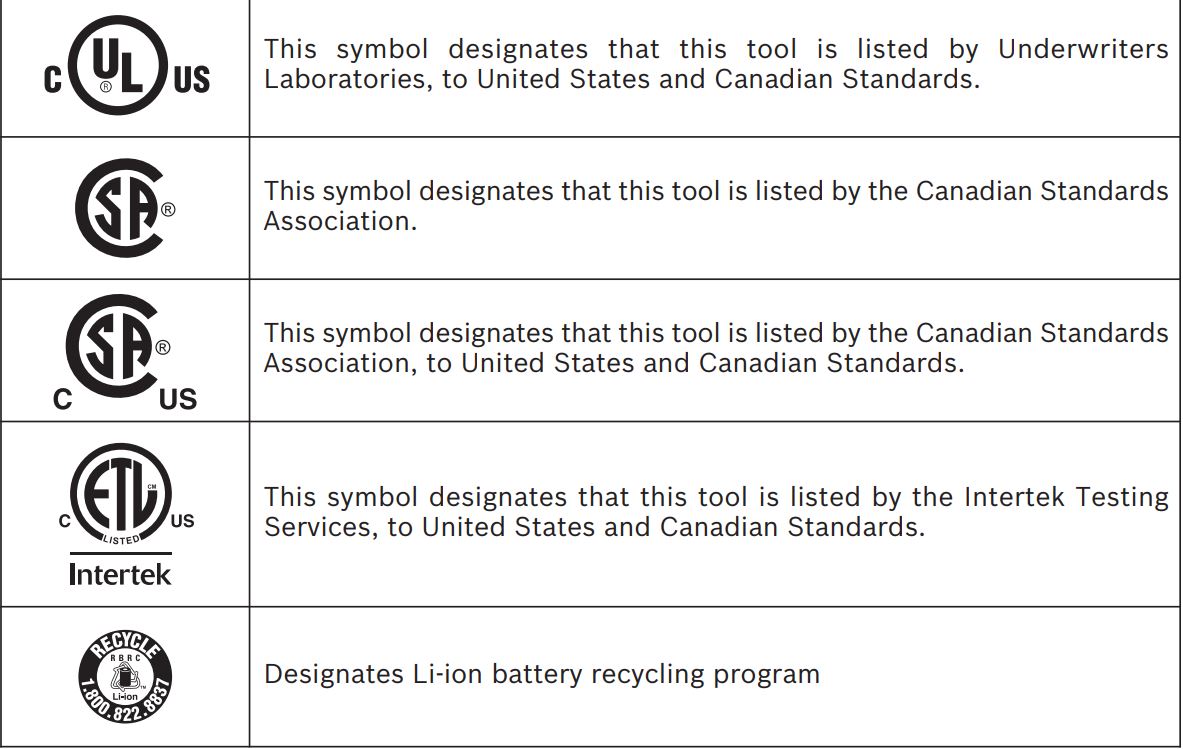
Functional Description and Specifications
⚠ Disconnect battery pack from tool before making any assembly, adjustments or changing accessories. Such preventive safety measures reduce the risk of starting the tool accidentally.
GWS12V-30 Cordless Angle Grinder with Side Switch
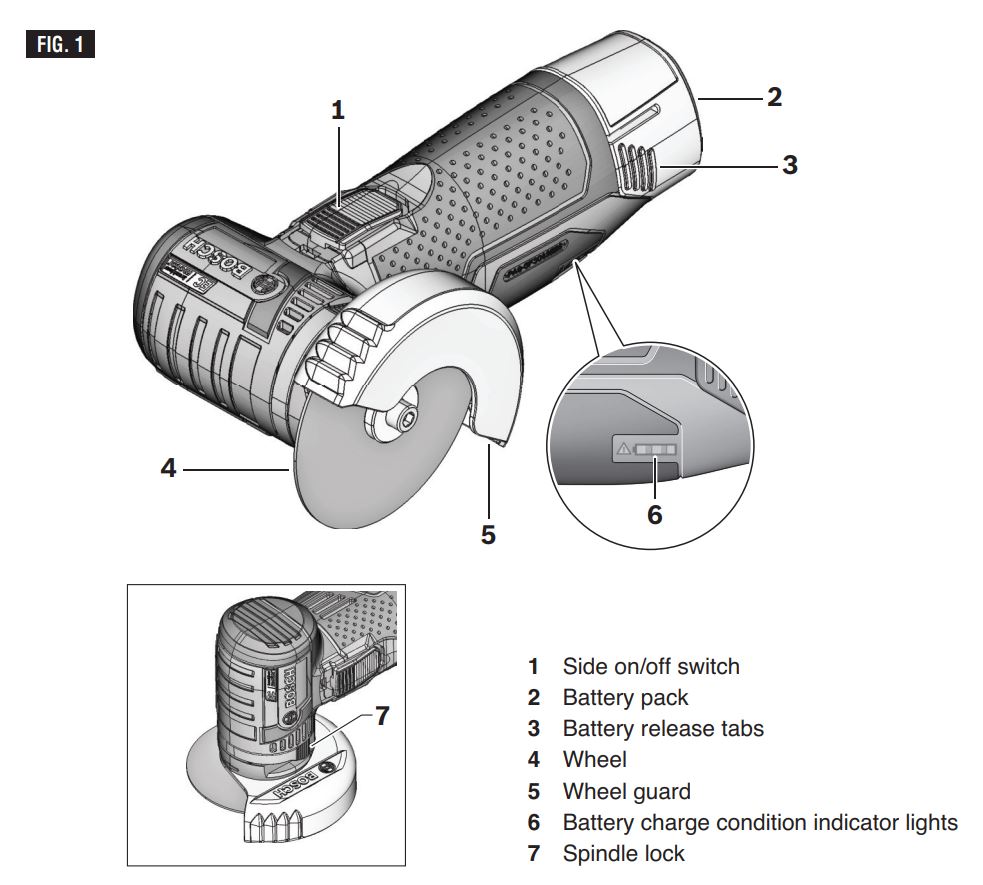
Battery Packs / Chargers: Please refer to the battery/charger list, included with your tool.
NOTE: For tool specifications refer to the nameplate on your tool.
Functional Description and Specifications
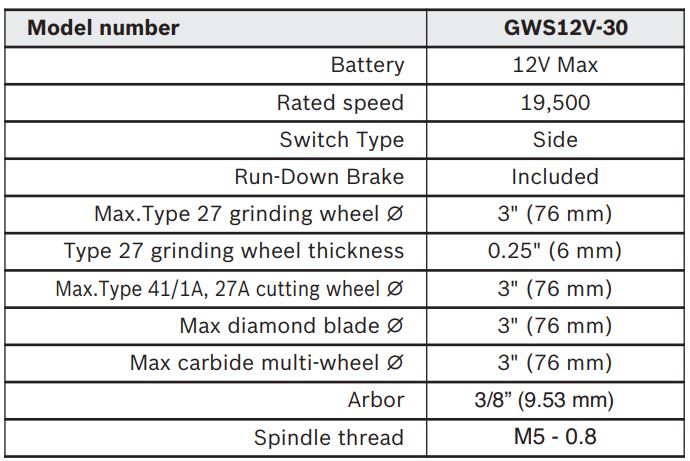
Application
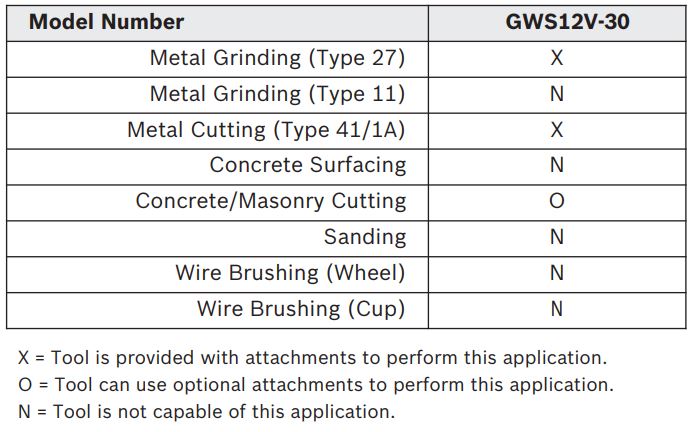
Accessory speed rating must be equal to or greater than the tool’s speed rating. Do not exceed the recommended wheel diameter.
Functional Descriptions
Automatic Restart Protection:
Helps prevent accidental startups after power has been interrupted, e.g. the tool was unplugged with the switch locked in the on position. To resume operation, turn on/off switch to the off position, then restart the tool. See the chart under Fig. 1 and Fig. 2 to find out which grinders are equipped with the Automatic Restart Protection.
Overload Protection:
Helps protect tool from excessive heat that may damage motor. If tool stops or slows during operation, allow motor to cool for 30 seconds by running no-load. If the overload protection stops the tool repeatedly, excessive force is causing the tool to overload. Stop excessive force and readjust work piece to reduce force applied.
Brake Operation
⚠ Let the grinder accessory come to a complete stop before setting the tool down. The brake action of this grinder is not intended as a safety feature. Using the appropriate guard when operating the grinder is your best protection against unintentional contact with a spinning accessory. Unintended contact with a rotating accessory can cause property damage andor personal injury.
⚠ Know the charge state of your battery. The electric braking action is initiated ONLY by the release of the trigger switch and in a tool that has power available. When electrical power is lost due to a discharged battery or other causes, the electric brake will not operate and the motor will gradually slow down. Unexpected run down time may cause property damage and/or personal injury.
Your grinder is equipped with an automatic electric brake which is designed to rapidly stop the accessory from spinning after you release the side trigger switch. This feature helps improve jobsite productivity.
Braking starts once the power is turned off. The brake requires a charged battery to function. Stopping time will vary depending on, among other factors, accessory used, and number of actuations. The electric brake of your grinder has been designed for a high degree of reliability, but unexpected circumstances such as contamination or failure of the motor’s components can cause the brake to not activate. If the tool operates but the brake does not consistently stop the accessory, DO NOT use the grinder and have it serviced by a Bosch Factory Service Center or Bosch authorized service facility.
Assembly
⚠ Disconnect battery pack from tool before making any assembly, adjustments or changing accessories. Such preventive safety measures reduce the risk of starting the tool accidentally.
Wheel Guard Adjustment
Wheel guard must be attached when using disc grinding or cutting wheels. Always keep wheel guard between you and your work while grinding or cutting.
TO ADJUST WHEEL GUARD
Disconnect battery pack from tool. The position of the guard (5) should be adjusted to the requirements of the work process. To do this, hold the body of the tool with one hand, and rotate the guard into position with the other hand (Fig. 2). Adjust the guard in such a manner that sparking is prevented in the direction of the operator.
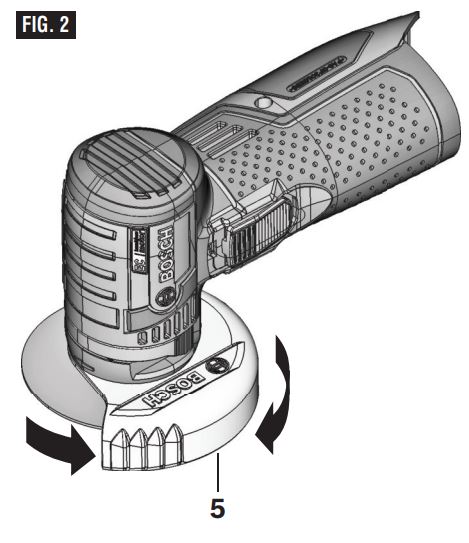
Grinding / Cutting Wheel Assembly
⚠ Only use accessories with Maximum Safe Operating Speed rated at least equal to the maximum speed marked on the power tool. This speed is based on the strength of the wheel. It is not meant to imply a best or most efficient operating speed. Do not exceed the Maximum Safe Operating Speed.
⚠ Do not pull the spindle locking bar while the spindle is moving. The power tool may become damaged if you do this.
⚠ Do not use accessories that run eccentrically. The tool will vibrate excessively and may cause loss of control and the accessory may burst.
Before attaching selected accessory check the dimensions of the abrasive wheel. The diameter of the bore must match that of the mounting flange. Do not use an adapter or reducer.
When using diamond cutting wheels, make sure that the direction of rotation arrow on the diamond cutting wheel corresponds to the direction of rotation of the machine (see direction of rotation arrow on the housing).
- Disconnect battery pack from tool.
- Pull out the spindle locking bar. If necessary, turn the spindle manually until it is locked in place.
- Use a hex key to remove the clamping bolt with washer and place the wheel onto the spindle.
- Screw in the clamping bolt with washer and tighten using a hex wrench until the washer of the bolt is flush with the wheel.
- Push the spindle locking bar back towards the housing of the tool.
- After attaching the wheel, check that the wheel is fitted correctly and can turn freely before switching on the power tool. Make sure that the disc does not brush against the protective guard or other parts.
TO REMOVE: Reverse procedure
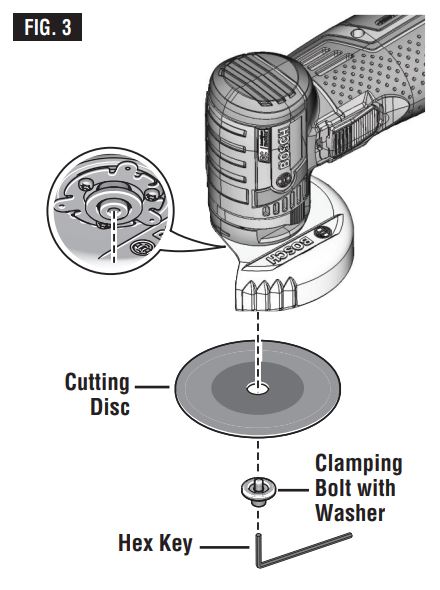
Inserting and Releasing Battery Pack
⚠ If battery release tabs are cracked or otherwise damaged, do not insert into tool. Battery can fall out during operation.
Release battery pack (2) from tool by pressing on both sides of the battery release tabs (3) and pull downward (Fig. 4). To insert battery, align battery and slide battery pack into tool until it locks into position. Do not force.
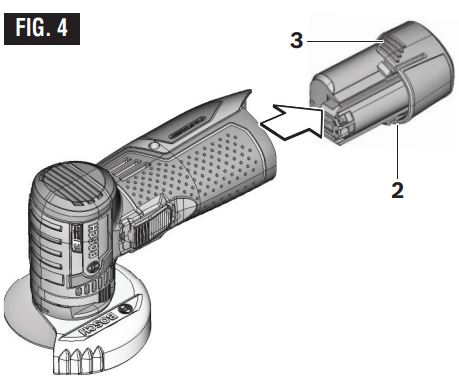
Operating Instructions
⚠ Never leave the trigger locked “ON”. Before connecting the power source, check that the trigger lock is “OFF”. Accidental startups could cause injury.
⚠ Be aware of the location and setting of the switch “Lock-ON” button. If the switch is locked “ON” during the use, be ready for emergency situations to switch it “OFF”.
⚠ Do not use the switch “Lock-ON” feature in situations where kickback is likely, such as when working into a corner. When the wheel binds, the tool will kick-back in opposite direction of wheel rotation and the release of the trigger “Lock-ON” may be difficult.
⚠ Hold the tool with both hands while starting the tool, since torque from the motor can cause the tool to twist.
Start the tool before applying to work and let the tool come to full speed before contacting the workpiece. Lift the tool from the work before releasing the switch. DO NOT turn the switch “ON” and “OFF” while the tool is under load; this will greatly decrease the switch life.
Side On-Off Switch with Lock
The tool is switched “ON” by the side switch (1) located at the side of the motor housing (Fig. 5). The switch can be locked in the “ON” position, a convenience for long grinding operations.
TO TURN THE TOOL “ON” without locking it, move the switch forward by applying pressure ONLY at the REAR portion of the switch. When pressure is released the switch will return to “OFF” position.
TO LOCK THE SWITCH “ON”, move the switch forward and press the FRONT portion.
TO UNLOCK THE SWITCH, simply press and release the REAR portion of the slider. Switch is spring loaded and will snap back automatically.
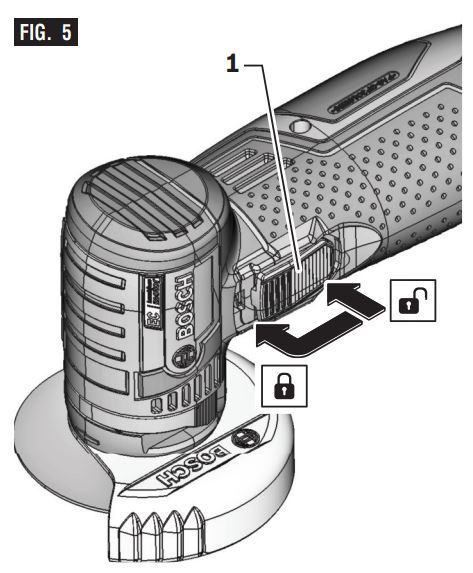
Grinding Operations
SELECTING GRINDING WHEELS
⚠ Rated RPM of the grinding or cutting wheel must be greater or equal to maximum RPM marked on the nameplate of the tool. Do not use wheels rated at lower RPM than the maximum RPM marked on the nameplate of the tool.
GRINDING WHEELS
Grinding wheels should be carefully selected in order to use the grinder most efficiently. Wheels vary in type of abrasive, bond, hardness, grit size and structure. The correct type of wheel to use is determined by the job. Use grinding wheels for fast grinding of structural steel, weld beads, steel casting, stainless steel and other ferrous metals.
GRINDING TIPS
Efficient grinding is achieved by controlling the pressure and keeping the angle between wheel and workpiece at 10° to 15° (Fig. 6). If the wheel is flat, the tool is difficult to control. If the angle is too steep, the pressure is concentrated on a small area causing burning to the work surface.
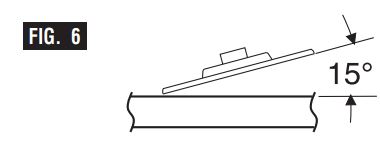 ⚠ Excessive or sudden pressure on the wheel will slow grinding action and put dangerous stresses on the wheel.
⚠ Excessive or sudden pressure on the wheel will slow grinding action and put dangerous stresses on the wheel.
When grinding with a new wheel be certain to grind while pulling tool backwards until wheel becomes rounded on its edge. New wheels have sharp corners which tend to “bite” or cut into workpiece when pushing forward.
Cutting Operations
METAL CUTTING
With this grinder it is possible to perform cutting of limited small stock such as metal tubes, piping or rebar. When cutting, work with moderate feed, adapted to the material being cut. When cutting profiles and square bar, it is best to start at the smallest cross section.
Always follow precautions for kickback.
- Allow the tool to reach full speed before touching the tool to the work surface.
- The tool should always be used in such way that the sparks are directed away from user.
- Apply minimum pressure to the work surface, allowing the tool to operate at high speed. Cutting rate is greatest when the tool operates at high speed.
- Do not exert side pressure onto the cutting disc. Do not tilt or oscillate the tool as wheel may burst, (Fig. 7).
- Remove the tool from the work surface before turning the tool off. Allow the tool to stop rotating before laying it down.
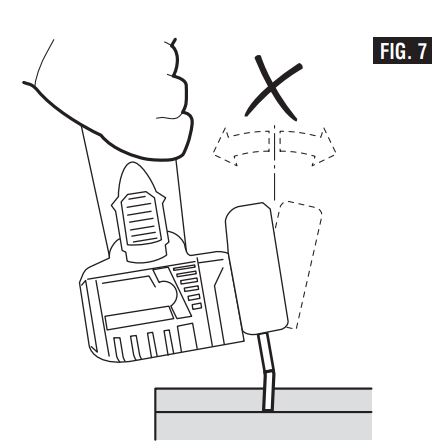
TILE / CERAMIC CUTTING
With this grinder it is possible to perform cutting of tile and ceramic materials. When cutting, work with moderate feed, adapted to the material being cut.
Always follow precautions for kickback.
Operate the tool with a dust extraction system and personal dust protection, e.g. respirator, dust mask, etc. The vacuum used for this application must be approved for the application. Bosch sells suitable vacuum cleaners.
⚠ Never pull the tool backward since blade will climb out of the material and KICKBACK will occur.
- Allow the tool to reach full speed before touching the tool to the work surface.
- If plunge cutting:
a. Tilt tool forward with wheel lined up with the cut line and hold the tool by the grinder body (Fig. 8).
b. Gradually lower the rear of tool using the front end of the guard as the hinge point.
c. With the guard on the surface, proceed cutting in forward direction to end of cut. - Always maintain contact between the guard and work piece.
- Slide the tool forward at a moderate speed adapted to the material being cut. Always cut towards the dust extraction port to maximize dust extraction and reduce likelihood of kickback (Fig. 9).
- Apply minimum pressure to the work surface, allowing the tool to operate at high speed. Cutting rate is greatest when the tool operates at high speed.
- When the cut is completed, remove tool from work piece before turning off. Allow wheel to stop rotating before setting tool down.
When cutting especially hard material, e. g., concrete with high pebble content, the dry diamond wheel can overheat and become damaged. This is clearly indicated by circular sparking of the rotating dry diamond wheel.
In this case, interrupt the cutting process and allow the dry diamond wheel to cool by running the tool for a short period of time at the maximum speed with no-load. Noticeable decreasing work progress and circular sparking are indications of a dry diamond wheel that has become dull. Briefly cutting into abrasive materials (e. g. brick) can resharpen the wheel.

Battery Charge Condition Indicator Lights
Your tool is equipped with charge condition indicator lights. The indicator lights show the charge condition of the battery while the tool is on, and for a seconds after the tool is turned off.
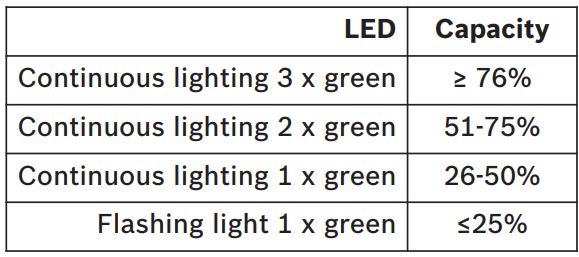
Temperature Control / Overload Protection Indicator
The red LED indicator helps you to protect the battery against overheating and the tool against overheating and overload.
If the LED indicator is lit up permanently in red, the temperature of the battery or drive unit is too high. The power tool switches off automatically. When this happens:
- Turn the switch to the off position.
- Allow the battery and power tool to cool down before you resume working.
If the LED indicator flashes red, the power tool is jammed and switches off automatically. When this happens: - Turn the switch to the off position.
- Remove the power tool from the workpiece.
As soon as the jam has been cleared and the disc is able to turn freely again, you can switch the power tool back on.
Maintenance
⚠ To avoid accidents, always disconnect the tool and/or charger from the power supply before servicing or cleaning.
Service
⚠ NO USER SERVICEABLE PARTS INSIDE.
Preventive maintenance performed by unauthorized personnel may result in misplacing of internal wires and components which could cause serious hazard. We recommend that all tool service be performed by a Bosch Factory Service Center or Authorized B
Batteries
Be alert for battery packs that are nearing their end of life. If you notice decreased tool performance or significantly shorter running time between charges then it is time to replace the battery pack. Failure to do so can cause the tool to operate improperly or damage the charger.
Tool Lubrication
Your Bosch tool has been properly lubricated and is ready for use.
D.C. Motors
The motor in your tool has been engineered for many hours of dependable service. To maintain peak efficiency of the motor, we recommend it be examined every six months. Only a genuine Bosch replacement motor specially designed for your tool should be used.
Cleaning
⚠ Certain cleaning agents and solvents damage plastic parts. Some of these are: gasoline, carbon tetrachloride, chlorinated cleaning solvents, ammonia and household detergents that contain ammonia.
Ventilation openings and switch levers must be kept clean and free of foreign matter. Do not attempt to clean by inserting pointed objects through opening.
Accessories and Attachments
⚠ The use of any other attachments or accessories not specified in this manual may create a hazard. Store accessories in a dry and temperate environment to avoid corrosion and deterioration.
⚠ Do not use Type 11 abrasive (cup) wheels with this tool. This tool is not designed for use with type 11 (cup) abrasive grinding wheels.
Notes
__________________________________________________________________________________________________________________________________________________________________________________________________________________________________________________________________________________________________________________________________________________________________________________________________________________________________________________________________________________________________________________
This page was intentionally left blank
LIMITED WARRANTY OF BOSCH PORTABLE AND BENCHTOP POWER TOOLS
Robert Bosch Tool Corporation (“Seller”) warrants to the original purchaser only, that all BOSCH portable and benchtop power tools will be free from defects in material or workmanship for a period of one year from date of purchase. SELLER’S SOLE OBLIGATION AND YOUR EXCLUSIVE REMEDY under this Limited Warranty and, to the extent permitted by law, any warranty or condition implied by law, shall be the repair or replacement of parts, without charge, which are defective in material or workmanship and which have not been misused, carelessly handled, or mis repaired by persons other than Seller or Authorized Service Station. To make a claim under this Limited Warranty, you must return the complete portable or benchtop power tool product, transportation prepaid, to any BOSCH Factory Service Center or Authorized Service Station. For Authorized BOSCH Power Tool Service Stations, please refer to your phone directory.
THIS LIMITED WARRANTY DOES NOT APPLY TO ACCESSORY ITEMS SUCH AS CIRCULAR SAW BLADES, DRILL BITS, ROUTER BITS, JIGSAW BLADES, SANDING BELTS, GRINDING WHEELS AND OTHER RELATED ITEMS.
ANY IMPLIED WARRANTIES SHALL BE LIMITED IN DURATION TO ONE YEAR FROM DATE OF PURCHASE. SOME STATES IN THE U.S., SOME CANADIAN PROVINCES DO NOT ALLOW LIMITATIONS ON HOW LONG AN IMPLIED WARRANTY LASTS, SO THE ABOVE LIMITATION MAY NOT APPLY TO YOU.
IN NO EVENT SHALL SELLER BE LIABLE FOR ANY INCIDENTAL OR CONSEQUENTIAL DAMAGES (INCLUDING BUT NOT LIMITED TO LIABILITY FOR LOSS OF PROFITS) ARISING FROM THE SALE OR USE OF THIS PRODUCT. SOME STATES IN THE U.S. AND SOME CANADIAN PROVINCES DO NOT ALLOW THE EXCLUSION OR LIMITATION OF INCIDENTAL OR CONSEQUENTIAL DAMAGES, SO THE ABOVE LIMITATION OR EXCLUSION MAY NOT APPLY TO YOU.
THIS LIMITED WARRANTY GIVES YOU SPECIFIC LEGAL RIGHTS, AND YOU MAY ALSO HAVE OTHER RIGHTS WHICH VARY FROM STATE TO STATE IN THE U.S., PROVINCE TO PROVINCE IN CANADA AND FROM COUNTRY TO COUNTRY.
THIS LIMITED WARRANTY APPLIES ONLY TO PORTABLE AND BENCHTOP ELECTRIC TOOLS SOLD WITHIN THE UNITED STATES OF AMERICA, CANADA AND THE COMMONWEALTH OF PUERTO RICO. FOR WARRANTY COVERAGE WITHIN OTHER COUNTRIES, CONTACT YOUR LOCAL BOSCH DEALER OR IMPORTER.
© Robert Bosch Tool Corporation 1800 W. Central Road Mt. Prospect, IL 60056-2230
Exportado por: Robert Bosch Tool Corporation Mt. Prospect, IL 60056-2230, E.U.A.
Importado a México por: Robert Bosch, S.A. de C.V., Calle
Robert Bosch No. 405, Zona Industrial, Toluca, Edo. de
México, C.P. 50070, Tel. (722) 2792300

